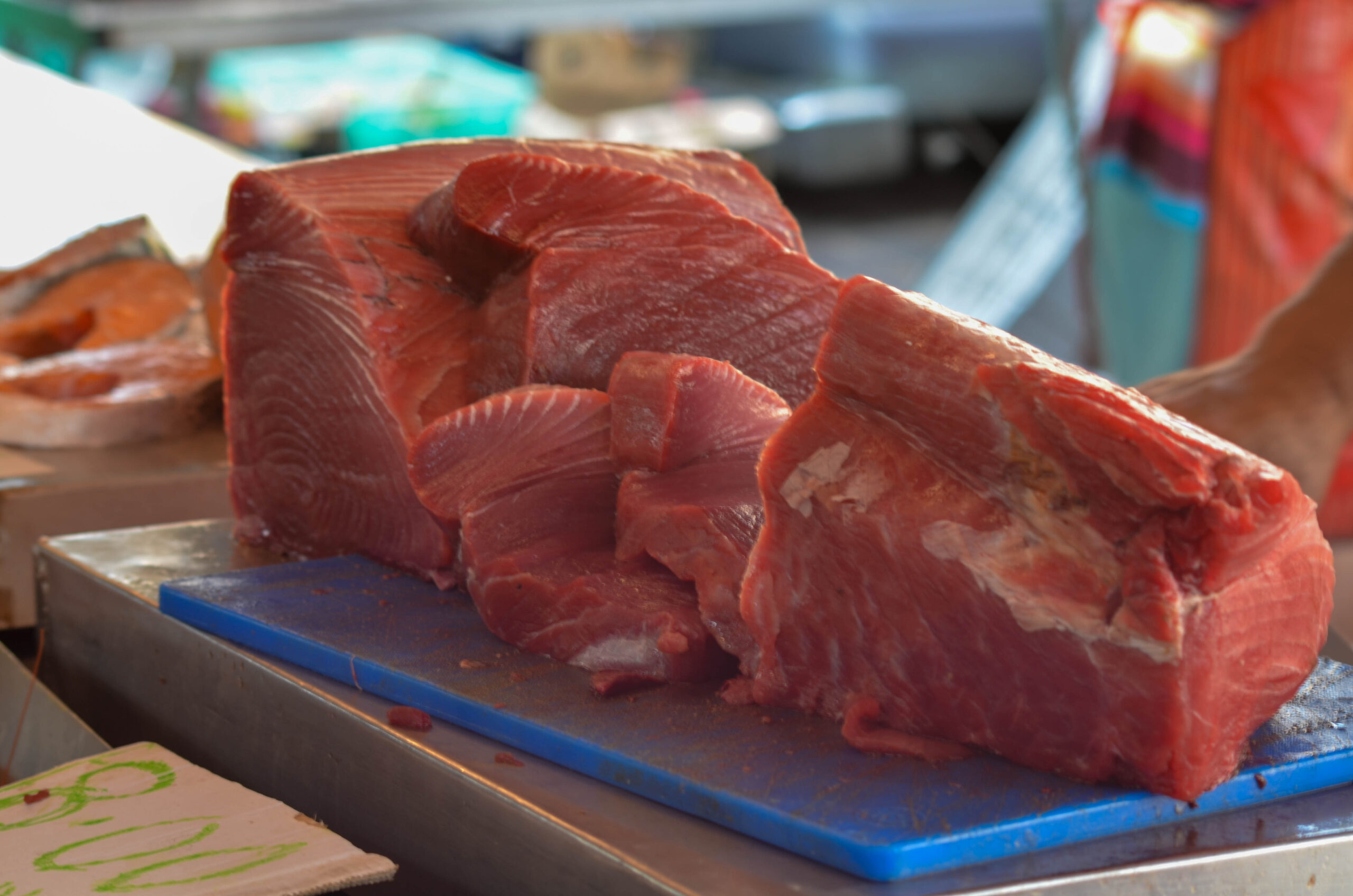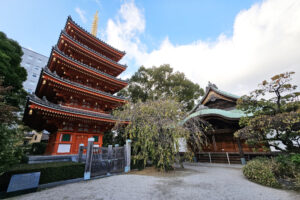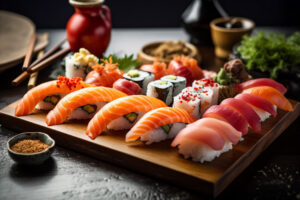===
In Japan, the meticulous craft of tuna cutting, known as "Tuna Saku," is both an art and a science. This tradition not only showcases the skills of the itamae, or master sushi chefs, but also reflects a deep cultural connection to the ocean and its bounty. As the demand for sushi and sashimi continues to rise globally, understanding the techniques, history, and significance of tuna cutting becomes increasingly essential for culinary practitioners and enthusiasts alike.
Understanding the Cultural Significance of Tuna Cutting
Tuna cutting is steeped in cultural significance in Japan, where food is often intertwined with tradition and seasonality. The act of cutting tuna is not merely a functional task but a ritualistic performance that honors the fish and the ocean it comes from. The meticulous movements of the itamae reflect a deep respect for the ingredients, where each slice symbolizes a celebration of nature’s gift.
In Japanese culture, the presentation of food is as important as its flavor. The way tuna is cut and presented can elevate a simple meal into an exquisite dining experience. It requires an appreciation of aesthetics and harmony, emphasizing the belief that how food looks influences how it tastes. This philosophy is evident in the precise and deliberate techniques employed by chefs during the cutting process.
Moreover, tuna cutting embodies the concept of “shokunin,” which emphasizes mastery and dedication to one’s craft. It highlights the idea that true artisans invest years, if not decades, honing their skills. This cultural reverence for dedication to craft ensures that the tradition of tuna cutting is passed down through generations, preserving both techniques and respect for the ingredients.
The cutting of tuna also serves as a form of storytelling, where each technique and style of slicing can reflect regional variations and personal touches of the chef. This storytelling aspect fosters a sense of identity and pride, making each tuna dish a narrative of its own, which diners appreciate and enjoy.
Within the realm of Japanese cuisine, tuna holds a special place, often regarded as a symbol of wealth and abundance. This symbolism further enhances the significance of tuna cutting as chefs strive to provide diners with a memorable experience that transcends the ordinary.
Finally, as global interest in sushi and sashimi continues to rise, the cultural significance of tuna cutting extends beyond Japan’s borders, inviting chefs and food lovers around the world to appreciate the depth and richness of this culinary tradition.
The History and Tradition Behind Tuna Cutting in Japan
The history of tuna cutting in Japan can be traced back several centuries, with roots deeply embedded in the fishing communities of the country. Initially, tuna was caught primarily for sustenance, but as trade and culinary practices evolved, it became a sought-after delicacy. The rise of sushi, particularly during the Edo period (1603–1868), solidified tuna’s status in Japanese cuisine.
During the Edo period, street vendors began selling nigiri-zushi, a precursor to modern sushi. Tuna quickly became a favorite because of its rich flavor and the ability to be preserved and transported easily. The need to prepare and cut the fish efficiently led to the development of specialized techniques and tools, as chefs sought to provide the best experience for their customers.
Traditionally, tuna cutting was regarded as a rite of passage for aspiring itamae. Young apprentices would spend years learning the nuances of fish selection, handling, and cutting techniques under the guidance of seasoned chefs. This apprenticeship system not only ensured the preservation of traditional methods but also fostered a deep respect for the culinary arts.
As sushi gained popularity beyond Japan’s shores, the techniques of tuna cutting began to spread to international culinary schools and restaurants. This globalization introduced variations and adaptations in cutting styles, yet many chefs still strive to maintain the authenticity of the Japanese tradition.
Additionally, tuna cutting ceremonies and competitions have become popular, showcasing the skill and artistry of professional chefs. These events not only celebrate the craft but also promote the importance of sustainability in tuna fishing, as overfishing has led to the depletion of certain tuna species.
In recent years, documentaries and culinary shows have further popularized the history and art of tuna cutting, inspiring a new generation to explore and appreciate this intricate craft. The tradition continues to evolve, but its historical roots remain a crucial part of Japan’s culinary heritage.
Essential Tools for Mastering Tuna Cutting Techniques
Mastering the art of tuna cutting requires a specific set of tools designed for precision and efficiency. The most essential tool is the slicing knife, known as a "yanagiba", which features a long, thin blade specifically designed for cutting fish. The single-edged blade allows for smooth, clean cuts, preserving the integrity of the flesh and enhancing presentation.
Another critical tool is the deba knife, which is thicker and sturdier than the yanagiba. It is primarily used for breaking down larger tunas into smaller portions before the delicate slicing begins. The deba knife’s weight and sharpness make it ideal for cutting through bones and thick skin, ensuring that the fish is prepared properly for further processing.
In addition to these main knives, a sushi mat or makisu can aid in the presentation of the finished product. This bamboo mat is essential for rolling sushi, ensuring that the rice and fish are perfectly aligned and evenly distributed. It also aids in creating visually appealing sushi rolls that can showcase expertly cut tuna.
A fish scaler is another useful tool used for preparing tuna. This tool allows chefs to quickly and efficiently remove scales from the surface of the fish, which is crucial for achieving a clean and polished appearance. Ensuring that the tuna is free of scales enhances both flavor and texture, contributing to the overall dining experience.
Maintaining these tools is equally important, as a well-kept knife is the hallmark of a skilled itamae. Regular sharpening, cleaning, and proper storage help preserve the knives’ effectiveness and longevity. Many chefs prefer traditional whetstones for sharpening, as they provide a precise edge that is essential for delicate cuts.
Finally, while the tools are critical, the skill and technique of the chef play a vital role in the cutting process. Experience, practice, and an understanding of the fish’s anatomy are essential for achieving the perfect cut, making the mastery of tuna cutting an intricate dance between tool and technique.
Step-by-Step Guide to Preparing a Tuna for Cutting
Preparing a tuna for cutting involves several crucial steps that require precision and care. The first step is selecting a fresh fish, which has a vibrant color, a clean aroma, and firm flesh. Once the tuna is sourced, the next step is to carefully inspect it for any signs of spoilage, ensuring that only the highest-quality fish is used for culinary purposes.
Once the fish is accepted, it must be properly cleaned. This begins with scaling the fish using a fish scaler, removing any unwanted scales that could impact the final presentation. Following this, the tuna should have its fins and tail removed with a sharp deba knife, allowing for easier handling during the cutting process.
Next, the fish is positioned on a clean cutting board, ideally made of wood or plastic, as these materials minimize the risk of contamination. It’s essential that the cutting surface is sanitized to prevent any unwanted flavors from affecting the fish. Ensuring a clean workspace is paramount in maintaining the quality of the final dish.
The itamae will then make an initial cut along the belly of the tuna, opening it up to remove the entrails. This step is crucial, as any remnants can spoil the fish and affect its flavor. Following this, the fish must be rinsed with cold water to remove any residual blood or impurities, further ensuring the freshness of the meat.
Once cleaned, the tuna is ready for filleting. The itamae will start by slicing along the backbone, separating the flesh into manageable portions. The objective is to create clean, even cuts that will allow for optimal presentation and flavor when served. Precision is key here, as the quality of each slice can greatly influence the sushi or sashimi experience.
Finally, after filleting, the chef should remove any remaining skin and connective tissue from the flesh. This meticulous attention to detail not only enhances the aesthetic appeal of the final dish but also ensures that diners experience the purest flavors of the fish. The prepared tuna can then be stored properly, ready for use in various culinary applications.
Key Tuna Species: Varieties and Their Culinary Uses
Tuna is a diverse species with several varieties, each offering distinct flavors and textures that cater to different culinary applications. Bluefin tuna, arguably the most prized of all, is known for its rich, buttery flavor and high-fat content. This species is often used for sashimi and premium sushi, where its delicate texture and vibrant color can be showcased.
Another popular variety is yellowfin tuna, which is slightly leaner than bluefin but still delivers a meaty flavor. Its versatility makes it a favorite for raw preparations, such as poke bowls, as well as for grilling and searing. Yellowfin tuna is often found in sushi rolls, where it can easily complement a variety of ingredients.
Albacore tuna, also known as white tuna, is characterized by its light-colored flesh and mild flavor. It is commonly used in canned tuna products but is also enjoyed fresh in sushi and sashimi. The soft texture of albacore makes it an excellent choice for blending with other ingredients, such as sauces and toppings.
Skipjack tuna is another variety that holds a significant place in Japanese cuisine. Known for its strong flavor and firm texture, skipjack is often used in making katsuobushi (dried bonito flakes), which serve as an ingredient in many traditional Japanese dishes, including dashi broth. Fresh skipjack can also be enjoyed as sashimi, offering a more robust taste.
The seasonal variations of these tuna species further enhance their culinary appeal. For example, bluefin tuna is often at its best in early summer, while yellowfin tuna peaks during late spring and early fall. Understanding the specific characteristics and best uses for each variety allows chefs to create dishes that highlight the unique flavors of the fish.
Additionally, sustainability is becoming increasingly important in tuna sourcing. Chefs are encouraged to choose species that are harvested responsibly, ensuring the longevity of tuna populations and marine ecosystems. This conscious approach not only reflects social responsibility but also enhances the overall dining experience as diners appreciate the story behind their meal.
The Role of the Itamae: Master Sushi Chefs Explained
The itamae is the heart and soul of the sushi experience, serving as both a chef and a custodian of tradition. This highly skilled culinary artisan is responsible for not only preparing the fish but also for crafting each dish to perfection. An itamae’s role extends far beyond mere food preparation; they are the gatekeepers of the rich history and artistry that define Japanese cuisine.
To become an itamae, one must undergo a rigorous apprenticeship, often lasting several years. This training process begins with mastering fundamental skills, such as knife techniques, ingredient selection, and flavor pairing. The path to becoming an itamae is steeped in discipline, requiring aspiring chefs to learn the nuances of their craft from seasoned mentors while adhering to the principles of respect and humility.
A significant part of an itamae’s role involves selecting the freshest and highest-quality ingredients. They must possess a keen understanding of seasonal variations in seafood, ensuring that only the best fish is served to customers. This dedication to quality reflects the itamae’s commitment to providing an exceptional dining experience.
In addition to technical skills, an itamae must also possess a deep appreciation for presentation. The aesthetic appeal of each dish is paramount, as it enhances the overall dining experience. An itamae carefully considers the arrangement of the fish, the choice of garnishes, and even the dish itself, ensuring that the final presentation is a work of art.
The itamae also interacts with diners, creating a connection that elevates the dining experience. This engagement can take many forms, from conversing about the food to explaining the sourcing and preparation methods of the dishes. An exceptional itamae can turn a meal into a memorable experience, leaving a lasting impression on guests.
As global interest in sushi grows, the role of the itamae is evolving. While many chefs are embracing modern techniques and innovations, they remain rooted in tradition, ensuring that the essence of Japanese culinary arts is preserved. The itamae embodies a beautiful balance between honoring the past and adapting to contemporary culinary trends, making them an essential figure in the world of sushi.
Traditional Techniques: Honing Skills Through Generations
The art of tuna cutting in Japan is defined by traditional techniques that have been passed down through generations. These techniques, often shrouded in secrecy, have evolved over centuries, ensuring that the craft of sushi-making remains true to its roots. Each technique is a product of cultural heritage, requiring both physical skill and mental discipline.
One of the fundamental techniques in tuna cutting is the "saku" style, where the fish is cut into rectangular blocks. This method preserves the structure of the flesh and allows for precise slicing into sashimi or nigiri. The technique emphasizes the importance of maintaining the integrity of each cut, ensuring that the fish retains its flavor and texture.
Another traditional technique is the "tataki" method, where the fish is seared briefly and then thinly sliced. This approach enhances the flavor profile while still highlighting the freshness of the tuna. It requires the itamae to have a deep understanding of cooking times and temperatures to achieve the perfect balance between searing and maintaining the raw essence of the fish.
To master these techniques, itamae often spend years in rigorous training, practicing their skills under the watchful eye of experienced mentors. This apprenticeship model ensures that the knowledge and artistry of tuna cutting are preserved and refined with each generation, creating a lineage of skill that is respected and cherished within the culinary community.
Additionally, many chefs engage in ryori, or culinary competitions, where they showcase their tuna-cutting skills. These events not only highlight individual talent but also foster a sense of camaraderie among chefs, as they share techniques and learn from one another. Such competitions serve as a platform for innovation while staying true to traditional methodologies.
The transfer of knowledge is also facilitated through various culinary schools and workshops, where aspiring chefs can learn the art of tuna cutting. This educational approach allows for the fusion of traditional techniques with modern practices, ensuring that the craft continues to evolve while honoring its heritage.
Ultimately, the dedication to preserving traditional techniques is a testament to the cultural significance of tuna cutting in Japan. As the culinary landscape continues to change, the commitment to honing skills through generations ensures that the artistry and craftsmanship of the itamae will endure.
The Importance of Freshness: Selecting the Best Tuna
In the world of sushi, freshness is paramount, and the selection of tuna is a critical factor that directly impacts the quality of the final dish. The ritual of choosing the right fish can be as intricate as the cutting techniques themselves. Freshness not only affects flavor and texture but also plays a crucial role in the safety of the seafood consumed.
When selecting tuna, several factors must be considered to ensure that the fish is of the highest quality. First and foremost, the fish should have a bright, unblemished color. For bluefin tuna, the flesh should be a deep red, while yellowfin should exhibit a vibrant pink hue. Any discoloration or dullness may indicate that the fish is past its prime.
Another indicator of freshness is the fish’s aroma. Fresh tuna should have a clean, ocean-like scent, reminiscent of the sea. If the fish emits a strong or unpleasant odor, it is best to avoid it, as it may signal spoilage. An itamae is trained to recognize these subtle cues, making them adept at selecting the finest ingredients.
The texture of the tuna is equally important. Fresh fish should have firm, resilient flesh that springs back when pressed. If the flesh feels mushy or lacks elasticity, it may be old or improperly handled. This tactile assessment is a skill honed through years of practice, allowing chefs to evaluate the quality of the fish with precision.
Additionally, the sourcing of tuna plays a vital role in ensuring freshness. Many itamae prefer to work with local fishmongers or suppliers who prioritize sustainable fishing practices. This connection not only supports local economies but also guarantees that the fish is caught and delivered in a timely manner, preserving its freshness.
Seasonality also influences the availability of certain tuna species, emphasizing the importance of understanding the fishing calendar. Chefs must remain aware of when specific varieties are at their peak, ensuring that their menus reflect the best options available. This seasonal awareness further enhances the dining experience, allowing guests to enjoy tuna at its finest.
In conclusion, the emphasis on freshness is a cornerstone of Japanese culinary tradition, particularly when it comes to tuna cutting. The dedication to selecting only the highest quality ingredients ensures that each dish served is a true reflection of the art and craftsmanship of the itamae.
Safety First: Best Practices for Tuna Cutting
In the culinary world, food safety is of utmost importance, especially when it comes to handling raw fish like tuna. The techniques employed in tuna cutting require not only precision but also an understanding of safety protocols to prevent contamination and ensure the health of diners. Itamae rely on established practices to maintain a clean and safe kitchen environment.
One of the first steps in ensuring food safety is proper hand hygiene. Chefs must wash their hands thoroughly before handling any ingredients, particularly raw fish. This practice helps to minimize the risk of cross-contamination, which can lead to foodborne illnesses. Regular handwashing is a non-negotiable rule in any professional kitchen.
In addition to hand hygiene, chefs should also pay attention to the cleanliness of their tools and workspace. Knives, cutting boards, and other utensils must be sanitized before and after use to prevent the spread of harmful bacteria. Many itamae utilize separate cutting boards for raw fish and other ingredients to further mitigate the risk of cross-contamination.
The temperature at which tuna is stored and handled is another critical aspect of food safety. Tuna should be kept chilled at a temperature of 32°F (0°C) or below to slow bacterial growth. It is essential to monitor the temperature of the refrigeration units regularly and to ensure that the fish is consumed or processed promptly after being removed from cold storage.
When cutting tuna, it is crucial to practice proper knife techniques to prevent injury. Chefs should always use sharp knives, as dull blades require more force, increasing the likelihood of accidents. Additionally, maintaining a clear and organized workstation minimizes distractions and allows chefs to focus on their tasks safely.
Training and education play a vital role in ensuring safety in the kitchen. Many culinary schools emphasize the importance of food safety practices, equipping aspiring chefs with the knowledge needed to handle raw ingredients responsibly. Continuous education and refresher courses are essential for experienced chefs to stay updated on best practices and regulations.
Finally, chefs must remain vigilant and aware of their surroundings while working with raw fish. This includes being mindful of potential allergens and dietary restrictions among diners. By adhering to strict safety protocols, itamae can ensure that their culinary creations are not only delicious but also safe for consumption.
Presentation Matters: Artful Ways to Serve Tuna
In Japanese cuisine, the presentation of food is considered an art form, and tuna is no exception. The way in which tuna is cut, arranged, and served plays a crucial role in the overall dining experience. An itamae’s attention to detail in presentation reflects their skill and dedication to the culinary craft.
One of the most traditional methods of serving tuna is sashimi, where the fish is sliced into thin, delicate pieces and served with garnishes. The presentation of sashimi often includes decorative elements such as shiso leaves, daikon radish, and edible flowers, which not only enhance the visual appeal but also complement the flavors of the fish.
For sushi, the preparation and presentation are equally important. A classic nigiri sushi consists of a slice of fish placed atop a small ball of vinegared rice. The itamae takes great care in shaping the rice and cutting the fish to ensure that each piece is








